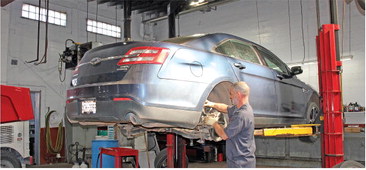Tire maintenance helps keep drivers safe


Maintaining tires is an important component of safe driving. Tires are some of the hardest working parts on a car or truck and are subjected to wear and tear every time rubber meets the road.
Tires affect many components of driving, including handling, braking and the comfort of the ride. Maintaining tires makes driving safe not only for drivers and their passengers, but also for fellow motorists.
The National Highway Traffic Safety Administration (NHTSA) says that, in 2017, 738 fatalities occurred because of tire-related crashes. Many of those crashes were no doubt preventable, and that only highlights the importance of maintaining tires and monitoring their performance.
Poor tire maintenance can lead to premature wear and potentially result in a blowout. The automotive group AAA notes it is important to visually inspect tires as often as possible. Drivers should look for overall tread wear. Pay special attention to tread wear on one edge of the tires, which could indicate poor alignment. Erratic tread wear may mean tires are out of balance.
Drivers also should pay attention to how their cars drive and sounds. Unusual vibration or thumping noises suggest issues with the tires. A car that pulls in one direction also may be experiencing tire problems.
Vehicle owners should be aware of the routine maintenance steps that can keep them safe and improve the life expectancy of tires.
Tire pressure. The NHTSA says only 19 percent of consumers properly check and inflate their tires. Keeping tires properly inflated is one of the most important steps to maintaining them. Tires lose around one psi per month, and under- inflated or overinflated tires can contribute to unusual wear, blowouts and even excessive fuel consumption.
Rotation. Check the owner’s manual or recommendations from the tire manufacturer, but know that most mechanics advise having tires rotated every 5,000 to 8,000 miles. Rotation helps distribute wear more evenly on tires. Balancing. AAA says balancing also helps minimize uneven wear and tear. Balanced tires are achieved by using small weights attached to the wheels to limit vibration of the tire and wheels as they turn. New tires should be balanced, and tires also should be balanced after one or more is removed to repair a puncture.
Alignment. Vehicles have wheel alignment measurements that pertain to manufacturers’ specifications. Alignment that falls outside of the range can impact handling, fuel economy and tread wear. A drift or pull suggests alignment problems and should be addressed.
Vehicle owners should keep tire inspection and maintenance in mind as part of their overall car care plan.

When looking at tire maintenance, it is also important to look at the entire wheel assembly including brakes and rotors. Here Brian Van Luven at Handel’s checks out a vehicle’s brakes.THE STAR NEWS





